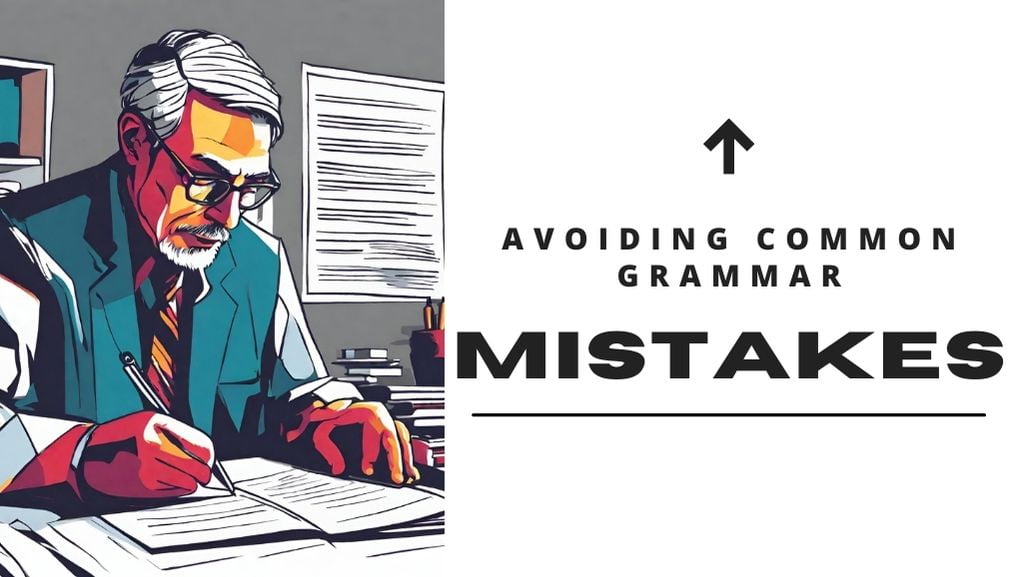Let’s get real: if you’re blogging to win, you can’t ignore grammar. Think of the best tool in your shed. That’s your grammar in blogging—it can make or break your game.
You wouldn’t show up to a hot event in a mismatched suit, right? Same goes for your blog. One grammar mess up? It’s like face-planting on the red carpet—in front of the cameras.
We’re going deep on why every comma, every period, and every carefully chosen word cements your reputation and authority. Stick with me, and let’s turn your blog into a credibility powerhouse that not only hooks your audience but also wins over those all-seeing search engines.
Ready to take your blog from good to awesome? Read on.
The Importance of Grammar in Blogging
In the bustling digital marketplace, your blog is your handshake, your business card, and your portfolio rolled into one.
Imagine walking into a room to pitch your next big project, and instead of greeting you with confidence, your presence is overshadowed by a mismatched outfit and a stumbling introduction.
That’s the equivalent of what poor grammar does to your blog posts.
Grammatical missteps can erode that vital first impression, much like a coffee stain on a white shirt during a job interview.
Your command of language in your writing doesn’t just convey information; it showcases your professionalism, hones your competence, and bolsters your credibility.
The way you put words together paints a picture of who you are and whether you’re to be taken seriously in the business world.
It’s not merely about being correct; it’s about demonstrating meticulousness and dedication to your craft.
A blog teeming with grammatical errors is like sending a symphony orchestra to play with untuned instruments – the message might be there, but the delivery grates on the senses.
This is about more than just the aesthetic of well-structured sentences; it’s about the voice behind the words.
The care you invest in crafting your message reflects not only your expertise but also your respect for the reader’s experience.
Now, shift focus from the reader’s lens to the search engine’s algorithms.
Modern search engines aren’t just scanning for keywords; they’re assessing your content’s quality.
Poor grammar doesn’t just trip up readers; it also flags to search engines that your content might be low value, pushing you down the rankings.
Just like a lighthouse beam gets scattered by fog, grammatical errors cloud the clarity of your content, making it difficult for search engines to see your value.
Continuing with the theme of clarity, let’s delve into engagement.
The rhythm of your writing, much like a drummer in a band, keeps the audience’s attention and drives the tempo of the piece.
Stumbling across a grammatical gaffe is like a drummer missing a beat – it’s jarring, disrupts the flow, and can throw off the entire performance.
These missteps can pull readers out of the moment, fracturing their focus and often leading to early exits.
Setting the Stage for Credibility and Professionalism
Think of your blog as a stage, and every post you publish is a performance.
The grammar you use sets the backdrop for your entire presentation. Just as a well-designed set can enhance a performance, flawless grammar can elevate the professional image you present to your audience.
Each careful selection of a word, each meticulously-placed comma, acts as a silent envoy, asserting your authority and expertise in your field.
In the same vein, grammar contributes to building your unique authorial voice.
A voice that resonates with authority and reliability can become a signature tune that your readers come to recognize and trust.
Shoddy grammar, on the other hand, strikes a discordant note, diminishing the hard-earned trust you’ve built with your audience.
It whispers of rushed work and skipped steps, even if the reality was countless hours of effort.
Understanding Grammar’s Role in SEO and Readability
As you seek to broaden your digital footprint, your ally is the algorithms of search engines. But they demand content that is not only rich in information but also in quality.
They’ve been taught to crawl through the web, favoring sites that exude expertise, authority, and trustworthiness, often abbreviated as E-A-T.
Your grammar plays an indirect but critical role in this evaluation.
Imagine a web of interconnected strands, each grammar rule an individual thread. When woven together precisely, they form the strong fabric of clear, understandable content that search engines and humans alike favor.
The stakes are high; errors in grammar can unravel this web, weakening your content’s structure, making it less visible to the probing algorithms that bestow rankings.
Maintaining reader engagement becomes a balancing act where grammar is a stabilizing force. It ensures that the path through your content is smooth, allowing readers to glide effortlessly from start to finish.
A misplaced modifier, a confusing run-on sentence, or a miscued subject-verb agreement can place hurdles on this path, tripping up your readers.
The result? A fractured narrative that could end a reader’s journey prematurely – an outcome that no blogger desires.
As you craft your blog posts, remember: grammar is more than a set of rules to follow – it’s the foundation upon which your content’s integrity, credibility, and effectiveness rest.

Common Grammatical Pitfalls in Blogging
Picture your blog as a well-functioning machine; every part must work correctly to ensure the whole system runs smoothly.
Now, think of grammar as the gears within this machine. When they’re aligned properly, your blog operates seamlessly, but even a small hiccup can cause the whole system to falter.
Common grammatical issues are often the culprits behind these hiccups, and it’s crucial to identify and correct them to keep your content engine humming.
Trouble with Homonyms and Homophones
Homonyms and homophones are like twins in the English language – they look or sound so similar that they’re often mistaken for one another.
This can wreak havoc on the clarity of your writing. For instance, confusing ‘there’ (a location), ‘their’ (belonging to them), and ‘they’re’ (they are) is a frequent trip-up for many bloggers.
Here’s a pro tip: always consider the context.
If you’re talking about a place, ‘there’ is your go-to.
If you’re referring to something that belongs to someone, ‘their’ is the ticket.
And when you mean to say ‘they are,’ condense it neatly into ‘they’re.’
It’s all about matching the word to its purpose in your sentence.
Remember, practice makes perfect.
Keep an eye on these tricksters, and soon enough, choosing the right one will become second nature.
Checking your work or using tools like grammar checkers can catch these errors before they confuse your readers.
The Apostrophe Dilemma: Ownership and Contractions
Apostrophes might seem tiny, but they hold immense power in punctuation, signifying possession or gluing words together in a contraction.
Think of ‘Bob’s burger’ (the burger belongs to Bob) versus ‘Bobs’ burgers’ (the burgers belong to multiple people named Bob).
The apostrophe tells you who owns what.
Now, let’s tackle contractions. These are like shortcuts in your writing, fusing words to make them quicker to read and more conversational.
‘It’s’ means ‘it is,’ whereas ‘its’ shows something belongs to ‘it.’ Placement is key—the apostrophe goes where the letters have been skipped.
To anchor these rules in your mind, try saying your sentence out loud.
If you can replace the word with ‘it is’ or ‘it has,’ then ‘it’s’ with an apostrophe is your match.
If not, ‘its’ without the apostrophe is what you’re after.
This trick can help you avoid common mix-ups and keep your writing clear and concise.
Tense Consistency and Subject-Verb Agreement
Keeping your verb tenses consistent is like staying on the same path while you’re hiking – you don’t want to wander off and get your readers lost.
Imagine telling a story about what you did last weekend, then suddenly switching to what you’re doing next weekend mid-sentence. It confuses your audience about when things are happening.
Stability is key.
If you start in the past tense, stay there.
This consistency helps your readers follow along without getting jostled by sudden shifts in time.
Subject-verb agreement might sound straightforward, but it can get tricky.
The rule is simple: singular subjects need singular verbs, and plural subjects require plural verbs.
‘The dog runs’ versus ‘The dogs run.’
When the subject of your sentence is a group or collection of things, though, it can throw you a curveball.
‘The team is winning’ (singular), as opposed to ‘The players are winning’ (plural).
Understanding these grammatical details and applying them diligently can transform your writing from good to great, allowing your readers to immerse themselves fully in your content without distraction.
By addressing these common pitfalls head-on, you’ll be on track to creating blog posts that are not only engaging but also grammatically polished.
Punctuation: The Make or Break of Sentence Structure
Punctuation, in the world of writing, is like the glue that holds a sentence together.
It may seem small, but it has the might to either make your message crystal clear or let it crumble into confusion.
Getting punctuation right is essential for ensuring that the hard work you put into your blog posts doesn’t get lost in translation.
Commas, Semicolons, and the Oxford Comma
Commas are the unsung heroes of sentence clarity, subtly guiding readers through the twists and turns of your thoughts.
They tell your readers when to pause, allowing each part of your sentence to stand out and be understood.
Then there’s the Oxford comma—the one that comes right after the second-to-last item in a list, before the ‘and’ or the ‘or.’
This little comma has sparked many debates. Some say it’s essential for avoiding confusion, while others argue it’s unnecessary.
For instance, take the sentence “We sell books, movies, and games.” That last comma before ‘and’ is the Oxford comma. It makes sure that ‘movies’ and ‘games’ are seen as separate items, not as a set.
The key is consistency.
If you decide to use the Oxford comma, do it every time you list three or more items.
It’s about making a choice and sticking to it, so your readers know what to expect.
Periods, Parentheses, and Quotation Placement
Periods are the full stops that bring each thought to a tidy end.
When you pair them with parentheses or quotation marks, things get a bit more specific.
With parentheses, if you’re wrapping up a complete sentence within them, the period goes inside (like this).
But if the parentheses are just part of a larger sentence (like this), then the period stays outside.
Quotation marks, on the other hand, have their own rules.
In American English, periods and commas cozy up inside the quotation marks, no matter what.
It may defy logic, but “The CEO said, ‘This is our year,'” locks the period inside those quotation marks.
It’s just how it’s done.
Hyphenation and Dashes: Connecting Thoughts and Words Properly
Hyphens, en dashes, and em dashes might look similar, but they have different jobs in writing.
Hyphens (-) are the shortest and they’re all about teamwork—they connect words into a single concept, like ‘part-time.’
They make sure readers see the words as a package deal, not separate entities.
The en dash () is the middle sibling in length and is used to indicate a range, such as “Read pages 40–50” or “The meeting is scheduled for 1:00–2:00 PM.”
It acts like a small bridge linking two related ideas.
Em dashes (—), the longest of the trio, add a dash of drama to your sentence. They can replace commas for a stronger pause, or stand in for parentheses to add a side note—like this.
Getting the hang of these punctuation marks means your writing will be clearer and more powerful.
Your readers will glide through your sentences, grasping your meaning without a hitch.
Remember, punctuation is the secret sauce that gives your writing its flavor, so use it wisely and watch your blog posts stand out.

Enhancing Your Blogs Readability
Your blog’s readability is the gateway to connecting with your audience.
Just as a shop owner arranges products for the best customer experience, you must craft your blog posts for easy consumption.
It’s not just about what you say; it’s about how you say it.
The goal is to make your readers’ journey through your content as smooth as a drive on an open highway.
Strategies to Improve Sentence Flow and Structure
To avoid run-on sentences, which are like a chain with too many links, focus on expressing one complete thought at a time.
Break up marathon-length sentences into shorter, more powerful ones that strike with the force of a well-timed punch.
To ensure logical flow, link your sentences like a sequence of dominos.
Each sentence should naturally lead to the next.
Start with a subject and a verb, and then build around them.
This creates complete sentences that stand strong on their own while contributing to the overall message.
Using signpost words such as ‘first,’ ‘next,’ and ‘finally’ can offer readers clear direction on where you’re taking them, preventing them from getting lost along the way.
Simplifying Language and Avoiding Jargon
Straightforward language ensures your writing is accessible to a wider audience.
You want your blog to be the digital equivalent of a neighborhood cafe where everyone feels welcome to join the conversation, not an exclusive club with a secret handshake.
Best practices for utilizing plain language involve:
– Keeping sentences short and packing them with meaning.
– Using bullet points and subheadings to break down complex ideas into bite-sized pieces.
This not only maximizes readership but enhances engagement. Readers are more likely to stick around when they can easily digest your content.
Remember, jargon can alienate readers who aren’t familiar with your industry’s lingo. Instead, choose words that open doors.
When you must use specialized terms, be sure to explain them. This builds trust and makes your blog a place where learning happens effortlessly.
The Perils of Over-Editing: When to Trust Your Instincts
Striking the right balance between grammatical precision and a conversational tone can be like walking a tightrope.
Lean too much towards formality, and your voice may become stiff, distancing readers.
On the flip side, a relaxed approach that’s too casual might undermine the authority you’re aiming to project.
The challenge is to know when to stop editing.
Over-editing can sand down the edges of your unique voice, leaving behind a bland, impersonal narrative.
It’s like overcooking a meal until it loses its flavor.
Your blog should reflect your authentic voice. Let your personality shine through your writing.
This connection is what turns casual readers into loyal followers.
Sometimes, a touch of imperfection makes your content relatable and human.
As you refine your posts, listen to your instincts. If a sentence sounds like something you’d naturally say, it likely has a place in your blog.
Your goal is to reach and resonate with your audience, not to craft the perfect piece of literature.
By focusing on clear, approachable language and trusting your voice, you’ll create blog posts that invite readers in, keep them engaged, and leave them wanting more.
Proofreading and Editing: Polishing Your Post
Every blog post is a miniature campaign, a mission to capture attention and convey a message.
It’s not just about the ideas you’re sharing; it’s also about the care you take in presenting those ideas.
Proofreading and editing aren’t the final hurdles; they’re the essential polish that turns your rough draft into a gleaming beacon of insight.
Why Proofreading Is Non-Negotiable for Bloggers
The truth is, proofreading is as important as the writing itself.
When errors slip into your posts, they become the focus, not your message.
These mistakes are like potholes on a road – they jolt the reader and make the journey less smooth.
Skipping proofreading can lead to consequences far beyond a momentary hiccup.
It can damage the image of your blog, chip away at your credibility, and even impact how much trust your readers place in what you say.
Proofreading improves the overall quality of your content.
It’s the difference between handing someone a wrinkled business card and one that’s crisp and clean.
It shows you value the reader’s experience and you’re not just tossing words into the digital wind.
Tools and Techniques for Effective Grammar Checks
In today’s world, you’ve got a toolkit of digital helpers ready to help you catch those typos and grammatical gremlins.
Grammar checking tools, like Grammarly, are like having an expert editor looking over your shoulder, ready to flag down even the smallest errors.
But these tools are just the start.
For a thorough clean-up, manual techniques are your best friends.
Try reading your post out loud; your ears might catch what your eyes miss.
Taking a break before you dive into editing can also give you fresh perspective, making it easier to spot discrepancies.
Best practices for manual editing don’t stop there.
Approach it in multiple stages, focusing on one aspect at a time.
Tackle spelling first, then grammar, sentence structure, and so on.
This systematic approach ensures nothing slips through the cracks.
The Value of a Second Set of Eyes: Seeking External Help
No matter how sharp your proofreading game is, there’s immense value in an external perspective.
Your familiarity with your own writing can sometimes make you blind to its flaws.
It’s like trying to tickle yourself – it just doesn’t work.
That’s where a fresh set of eyes comes in.
A colleague, a friend, or a professional editor can spot things you’ve missed.
But they’re not just there to point out typos – they can give you insights on clarity, tone, and the overall feel of your post.
This unbiased feedback is crucial.
It’s not about criticism; it’s about elevating the quality of your content.
An external review can confirm that your message is not only error-free but resonates with clarity and purpose.
Remember, proofreading and editing are your allies.
They ensure that when your post goes live, it’s the best representation of your ideas and your brand.
So don’t rush the process – give your content the attention it deserves, and your readers will do the same.

Wrapping Up
Let’s cut to the chase—you now know grammar is your blogging superpower.
It’s not about going crazy over rules; it’s about making a smooth ride for your readers and shining in search engine spotlights.
Your blog is your brand’s beating heart, and every post needs to pulse with professionalism and personality.
Here’s your action plan:
- Proofread like a pro
- Choose your words carefully
- Make each sentence stand out
- Consider grammar checkers your secret weapon, but never underestimate the power of a human touch
- Read your work out loud
- Break it down
- And if in doubt, get a fresh pair of eyes on it before you hit ‘publish.’
You’re not just writing; you’re making experiences.
Keep it clear, keep it engaging, and above all, keep it true to your voice.
Your blog isn’t just a bunch of posts – it’s your legacy.
Make it count.
Now go make waves with words that work.



